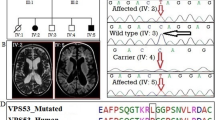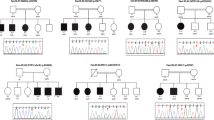Abstract
Background
Neurodevelopmental disorders are heterogeneous due to underlying multiple shared genetic pathways and risk factors. Intellectual disability, epilepsy and autism spectrum disorder phenotypes overlap which indicates the diverse effects of common genes. Recent studies suggested the probable contribution of CNTNAP2 gene polymorphisms to the comorbidity of these neurological conditions.
Methods and results
This study was conducted to investigate the role of CNTNAP2 polymorphisms rs147815978 (G>T) and rs2710102 (A>G) as a risk factor for comorbidity of intellectual disability and epilepsy in a group of 345 individuals including 170 patients and 175 healthy controls recruited from various ethnic groups of Pakistani population. Our case–control study group was genotyped by tetra primer ARMS-PCR technique and results were analysed to know the effects of CNTNAP2 rs147815978 (G>T) and rs2710102 (A>G) polymorphisms in the group. The frequency of risk allele T (rs147815978) and risk allele G (rs2710102) for homozygous recessive genotypes (TT/GG) in our study group was 36.47% while odds ratios for risk allele T (rs147815978) was 5.45 (3.90–7.61: 95% CI, P = 0.000) and that for risk allele G (rs2710102) was 2.39 (1.76–3.24: 95% CI, P = 0.0001). Homozygous recessive genotypes (TT/GG) appeared only in cases and not in control group which indicated these as suspected risk genotypes and the significant association (p < 0.05%) of CNTNAP2 gene polymorphisms rs147815978 (G>T) and rs2710102 (A>G) with co-occurrence of intellectual disability and epilepsy phenotypes in our study group which is in HWE (χ2 = 174, P < 0.0001). Logistic regression analysis shows additive (p < 0.0001) and multiplicative (p < 0.001) models which confirms significant association of both the polymorphisms in our data, which are closely located on same haplotype (D′ = − 0.168).
Conclusions
We propose that CNTNAP2 rs147815978 (G>T) and rs2710102 (A>G) polymorphisms are possible risk loci for overlap** neurodevelopmental disorders in Pakistani population. We propose the role of a previously reported common SNP rs2710102 (A>G) with a rarely reported novel SNP rs147815978 (G>T) for CNTNAP2 gene association with neurodevelopmental disorders in our data. Our study has expanded the knowledge of CNTNAP2 gene polymorphisms as probable biomarkers for susceptibility of co-occurrence of intellectual disability and epilepsy phenotypes in Pakistani population. We hope that our study will open new horizons of CNTNAP2 gene variants research to cure the neurological conditions in Pakistani population where consanguinity is a tradition and prevalence of neurodevelopmental disorders has increased from 1 to 2% during last 5 years.




Similar content being viewed by others
Data availability
The data supporting this study findings is available on request from the authors.
Abbreviations
- BBH:
-
Benazir Bhutto hospital
- OPD:
-
Outpatient door
- NDD:
-
Neurodevelopmental disorders
References
Toma C et al (2018) Comprehensive cross-disorder analyses of CNTNAP2 suggest it is unlikely to be a primary risk gene for psychiatric disorders. PLOS Genet 14(12):e1007535. https://doi.org/10.1371/journal.pgen.1007535
Falsaperla R et al (2022) Intronic variant in CNTNAP2 gene in a boy with remarkable conduct disorder minor facial features mild intellectual disability and seizures. Front Pediatr. https://doi.org/10.3389/fped.2020.00550
Perfilyeva A, Bespalova K, Abylkassymova G, Bekmanov B, Djansugurova L (2022) rs2710102 polymorphism of the cntnap2 gene is related to autism susceptibility in a Kazakhstani population. In J Biol Chem 15(1):11–19. https://doi.org/10.26577/ijbch.2022.v15.i1.02
Shiota Y et al (2021) A common variant of CNTNAP2 is associated with sub-threshold autistic traits and intellectual disability. PLoS ONE 16(12):e0260548. https://doi.org/10.1371/journal.pone.0260548
Uddin MS et al (2021) CNTNAP2 gene polymorphisms in autism spectrum disorder and language impairment among Bangladeshi children: a case–control study combined with a meta-analysis. Hum Cell 34(5):1410–1423. https://doi.org/10.1007/s13577-021-00546-8
St George-Hyslop F, Haneklaus M, Kivisild T, Livesey FJ (2023) Loss of CNTNAP2 alters human cortical excitatory neuron differentiation and neural network development. Biol Psychiatry 94(10):780–791. https://doi.org/10.1016/j.biopsych.2023.03.014
Parenti I, Rabaneda LG, Schoen H, Novarino G (2020) Neurodevelopmental disorders: from genetics to functional pathways. Trends Neurosci 43(8):608–621. https://doi.org/10.1016/j.tins.2020.05.004
Variants of the CNTNAP2 5′ promoter as risk factors for autism spectrum disorders: a genetic and functional approach | Molecular Psychiatry. from https://www.nature.com/articles/mp2014103. Accessed 01 May 2023
Association between Genetic Variants in DUSP15, CNTNAP2, and PCDHA Genes and Risk of Childhood Autism Spectrum Disorder. from https://www.hindawi.com/journals/bn/2021/4150926/. Accessed 01 May 2023
Poot M (2017) Intragenic CNTNAP2 deletions: a bridge too far? Mol Syndromol 8(3):118–130. https://doi.org/10.1159/000456021
Lu P et al (2021) A novel CNTNAP2 mutation results in abnormal neuronal E/I balance. Front Neurol. https://doi.org/10.3389/fneur.2021.712773
**ong W, Zhou D (2017) Progress in unraveling the genetic etiology of Rolandic epilepsy. Seizure 47:99–104. https://doi.org/10.1016/j.seizure.2017.02.012
Nykamp K et al (2017) Sherloc: a comprehensive refinement of the ACMG-AMP variant classification criteria. Genet Med Off J Am Colloid Med Genet 19(10):1105–1117. https://doi.org/10.1038/gim.2017.37
Li D et al (2021) Common variants of the autism associated CNTNAP2 gene contribute to the modulatory effect of social function mediated by temporal cortex. Behav Brain Res 409:113319. https://doi.org/10.1016/j.bbr.2021.113319
Freri E et al (2021) Severe epilepsy in CNTNAP2-related Pitt-Hopkins-like syndrome successfully treated with stiripentol. Seizure Eur J Epilepsy 88:143–145. https://doi.org/10.1016/j.seizure.2021.04.012
Beiranvandi F, Akouchekian M, Javadi GR, Darvish H (2020) The association of CNTNAP2 rs2710102 and ENGRAILED-2 rs1861972 genes polymorphism and autism in Iranian population. Meta Gene 24:100664. https://doi.org/10.1016/j.mgene.2020.100664
Khalid M et al (2020) Genetic risk of autism spectrum disorder in a Pakistani population. Genes 11(10):1206. https://doi.org/10.3390/genes11101206
Andres EM et al (2021) Study of rare genetic variants in TM4SF20, NFXL1, CNTNAP2, and ATP2C2 in Pakistani probands and families with language impairment. Meta Gene 30:100966. https://doi.org/10.1016/j.mgene.2021.100966
Badshah N et al (2022) Novel missense CNTNAP2 variant identified in two consanguineous Pakistani families with developmental delay, epilepsy, intellectual disability, and aggressive behavior. Front Neurol 13:918022. https://doi.org/10.3389/fneur.2022.918022
Rodenas-Cuadrado P, Ho J, Vernes SC (2014) Shining a light on CNTNAP2, complex functions to complex disorders. Eur J Hum Genet. https://doi.org/10.1038/ejhg.2013.100
Bobbili DR et al (2018) Exome-wide analysis of mutational burden in patients with typical and atypical Rolandic epilepsy. Eur J Hum Genet EJHG 26(2):258–264. https://doi.org/10.1038/s41431-017-0034-x
Usmanullah AKB (2022) Prevalence of epilepsy with autosomal recessive intellectual disability in consanguineous families. Pak J Med Health Sci. https://doi.org/10.53350/pjmhs221641195
Zhang L, Strug LJ, Sun L (2023) Leveraging Hardy–Weinberg disequilibrium for association testing in case-control studies. Ann Appl Stat 17(2):1764–1781. https://doi.org/10.1214/22-AOAS1695
Bustos MA et al (2023) Association of the rs2111234, rs3135499, rs8057341 polymorphisms in the NOD2 gene with leprosy: a case-control study in the Norte de Santander, Colombia population. PLoS ONE 18(3):e0281553. https://doi.org/10.1371/journal.pone.0281553
Humphries EM et al (2023) Genome-wide significant risk loci for mood disorders in the old order Amish founder population. Mol Psychiatry. https://doi.org/10.1038/s41380-023-02014-1
Lazaro MT et al (2019) Reduced prefrontal synaptic connectivity and disturbed oscillatory population dynamics in the CNTNAP2 model of autism. Cell Rep 27(9):2567–2578.e6. https://doi.org/10.1016/j.celrep.2019.05.006
Ji W et al (2013) CNTNAP2 is significantly associated with schizophrenia and major depression in the Han Chinese population. Psychiatry Res 207(3):225–228. https://doi.org/10.1016/j.psychres.2012.09.024
Peñagarikano O, Geschwind DH (2012) What does CNTNAP2 reveal about autism spectrum disorder? Trends Mol Med 18(3):156–163. https://doi.org/10.1016/j.molmed.2012.01.003
Zare S, Mashayekhi F, Bidabadi E (2017) The association of CNTNAP2 rs7794745 gene polymorphism and autism in Iranian population. J Clin Neurosci 39:189–192. https://doi.org/10.1016/j.jocn.2017.01.008
Nurgalieva AK et al (2023) Analysis of associations of alleles and genotypes of polymorphic loci of a range of candidate genes with phenotypic variations at the level of intelligence. Opera Med Physiol 10(1):37–52
D’Onofrio G et al (2023) Genotype–phenotype correlation in contactin-associated protein-like 2 (CNTNAP-2) developmental disorder. Hum Genet. https://doi.org/10.1007/s00439-023-02552-2
Smogavec M et al (2016) Eight further individuals with intellectual disability and epilepsy carrying bi-allelic CNTNAP2 aberrations allow delineation of the mutational and phenotypic spectrum. J Med Genet 53(12):820. https://doi.org/10.1136/jmedgenet-2016-103880
Datta A et al (2020) Association study of IL10 gene polymorphisms (rs1800872 and rs1800896) with cervical cancer in the Bangladeshi women. Int Immunopharmacol 89:107091. https://doi.org/10.1016/j.intimp.2020.107091
Wang L, Kang H, Hu Y, Wu Y (2023) Prenatal diagnosis and genetic analysis of two cases of Turner syndrome due to isodicentric Xp11.22. J Med Genet 40(3):368–373. https://doi.org/10.3760/cma.j.cn511374-20210911-00743
Dos T, Gonçalves S et al (2023) Genetic recurrence and molecular markers of dyslexia in the Brazilian population. Rev CEFAC 25:e8722. https://doi.org/10.1590/1982-0216/20232528722
Akter H et al (2023) Construction of copy number variation landscape and characterization of associated genes in a Bangladeshi cohort of neurodevelopmental disorders. Front Genet. https://doi.org/10.3389/fgene.2023.955631
Asif M et al (2023) Whole-exome sequencing of Pakistani consanguineous families identified pathogenic variants in genes of intellectual disability. Genes. https://doi.org/10.3390/genes14010048
McIntosh AM et al (2023) Comorbidities in newly diagnosed epilepsy: pre-existing health conditions are common and complex across age groups. Epilepsy Behav 138:108960. https://doi.org/10.1016/j.yebeh.2022.108960
Aparicio P, Barba R, Moldenhauer F, Suárez C, Real de Asúa D (2023) What brings adults with down syndrome to the hospital? A retrospective review of a Spanish cohort between 1997 and 2014. J Appl Res Intellect Disabil 36(1):143–152. https://doi.org/10.1111/jar.13043
Ibrahim A, Ahdi S, Rafique S, Alvi J, Wasim A, Sultan T (2023) Spectrum of neurological disorders in children: frequency, distribution, pattern and related factors. Pak Pediatr J 47:61–66
Alvi MH et al (2023) Economic burden of mental illness in Pakistan: an estimation for the year 2020 from existing evidence. BJPsych Int. 20(3):54–56. https://doi.org/10.1192/bji.2023.4
Hindawi (2023) Table 6 | Multiple gene polymorphisms associated with exfoliation syndrome in the Uygur population. https://www.hindawi.com/journals/joph/2019/9687823/tab6/
Li Y et al (2022) DIP2C polymorphisms are implicated in susceptibility and clinical phenotypes of autism spectrum disorder. Psychiatry Res 316:114792. https://doi.org/10.1016/j.psychres.2022.114792
Werling AM et al (2016) CNTNAP2 gene in high functioning autism: no association according to family and meta-analysis approaches. J Neural Transm 123(3):353–363. https://doi.org/10.1007/s00702-015-1458-5
Nascimento PP, Bossolani-Martins AL, Rosan DB, Mattos LC, Brandão-Mattos C, Fett-Conte AC (2016) Single nucleotide polymorphisms in the CNTNAP2 gene in Brazilian patients with autistic spectrum disorder. Genet Mol Res. https://doi.org/10.4238/gmr.15017422
Irfan H, Sharif A, Sabir I, Watto S, Zaman M (2023) The qualitative report the qualitative report ties that blind: a longitudinal study on consanguinity and ties that blind: a longitudinal study on consanguinity and congenital disorders in Kabirwala, Pakistan congenital disorders in Kabirwala, Pakistan. Qual Rep. https://doi.org/10.46743/2160-3715/2023.6120
Ahmad N et al (2023) “Prevalence of congenital defects among consanguineous marriages in Pakistan. J Soc Prev Advocacy Res KEMU 2(1):1. Accessed 9 Dec 2023. [Online]. Available: https://journalofspark.com/journal/index.php/JSpark/article/view/107
Acknowledgements
We are thankful to all the patients for participating in the study. Special thanks to Holy Family Hospital and BBH for providing diagnostic facilities to the patients. Highly indebted to Translational Genomics Lab COMSATS University Islamabad for providing sample storage, DNA extraction, primer designing and optimization, ARMS-PCR facilities. Special thanks to IBGE, KRL for providing data analysis support.
Funding
The study has been conducted through the funds provided by grant # NRPU Project No.16281, Higher Education Commission Pakistan, awarded to Dr. Zehra Agha from Translational Genomics Lab, COMSATS University, Islamabad.
Author information
Authors and Affiliations
Contributions
BM has designed the study, collected blood samples, performed experimental work, and written the first draft of the manuscript. ZA has supervised the study and provided data analysis support for the final draft of the manuscript.
Corresponding author
Ethics declarations
Competing interests
Authors declare no competing interests.
Ethical approval
This study was approved by the Institutional Review Board of Department of Biosciences, The COMSATS University, Islamabad (CUI-Reg/Notif-1616/18/2/27 dated 5th June 2018).
Informed consent
Written informed consent for clinical and genetic testing, publication of information was provided by attendants of patients. Diagnosis was carried out in collaboration with the neurological consultants in their OPD clinics at Holy family Hospital and BBH, Rawalpindi.
Additional information
Publisher's Note
Springer Nature remains neutral with regard to jurisdictional claims in published maps and institutional affiliations.
Rights and permissions
About this article
Cite this article
Ul Mudassir, B., Agha, Z. Novel and known minor alleles of CNTNAP2 gene variants are associated with comorbidity of intellectual disability and epilepsy phenotypes: a case–control association study reveals potential biomarkers. Mol Biol Rep 51, 276 (2024). https://doi.org/10.1007/s11033-023-09176-9
Received:
Accepted:
Published:
DOI: https://doi.org/10.1007/s11033-023-09176-9




